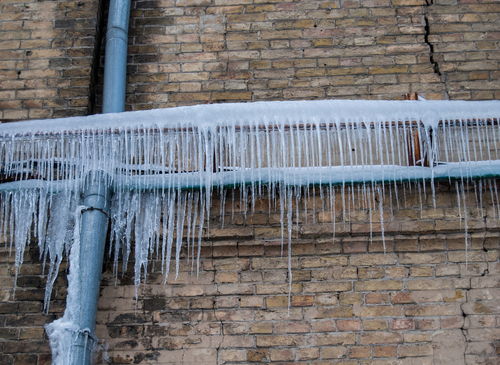Have you been interested in insight concerning Winter Plumbing Precautions: Preventing Frozen Pipes?

Cold weather can ruin your pipes, particularly by freezing pipelines. Here's just how to avoid it from taking place and what to do if it does.
Introduction
As temperature levels decrease, the threat of icy pipes rises, potentially causing costly repair services and water damages. Understanding exactly how to stop frozen pipelines is crucial for property owners in chilly environments.
Avoidance Tips
Protecting at risk pipelines
Wrap pipelines in insulation sleeves or make use of warm tape to secure them from freezing temperature levels. Focus on pipes in unheated or exterior areas of the home.
Heating methods
Maintain indoor rooms properly heated up, particularly areas with plumbing. Open cabinet doors to allow cozy air to flow around pipelines under sinks.
Just how to determine frozen pipelines
Seek lowered water circulation from faucets, unusual smells or sounds from pipelines, and noticeable frost on subjected pipes.
Long-Term Solutions
Structural changes
Think about rerouting pipes far from outside walls or unheated locations. Include extra insulation to attic rooms, cellars, and crawl spaces.
Updating insulation
Invest in high-quality insulation for pipelines, attics, and wall surfaces. Proper insulation aids maintain regular temperatures and lowers the danger of icy pipes.
Securing Outdoor Pipes
Yard hose pipes and exterior faucets
Detach and drain pipes garden pipes prior to winter season. Set up frost-proof spigots or cover exterior taps with insulated caps.
Comprehending Icy Pipelines
What causes pipes to freeze?
Pipelines ice up when exposed to temperatures below 32 ° F (0 ° C) for expanded periods. As water inside the pipes freezes, it broadens, putting pressure on the pipeline wall surfaces and possibly creating them to break.
Threats and damages
Icy pipelines can result in water supply disruptions, property damages, and pricey repair work. Ruptured pipes can flooding homes and cause extensive architectural damages.
Indicators of Frozen Piping
Recognizing frozen pipelines early can stop them from breaking.
What to Do If Your Pipelines Freeze
Immediate actions to take
If you believe frozen pipelines, keep faucets open up to ease stress as the ice melts. Utilize a hairdryer or towels taken in warm water to thaw pipes gradually.
Verdict
Protecting against icy pipelines needs aggressive measures and fast actions. By comprehending the causes, signs, and safety nets, house owners can safeguard their plumbing throughout cold weather.
6 Proven Ways to Prevent Frozen Pipes and Protect Your Home
Disconnect and Drain Garden Hoses
Before winter arrives, start by disconnecting your garden hoses and draining any remaining water. Close the shut-off valves that supply outdoor hose bibs and leave the outdoor faucet open to allow any residual water to drain. For extra protection, consider using faucet covers throughout the colder months. It’s also important to drain water from any sprinkler supply lines following the manufacturer’s directions.
Insulate Exposed Pipes
Insulating your pipes is an effective way to prevent freezing. Pipe insulation is readily available at home improvement stores and is relatively inexpensive. Pay close attention to pipes in unheated areas such as the attic, basement, crawl spaces, or garage. Apply foam insulation generously to create a buffer against the cold. You can also wrap your pipes in heat tape or thermostat-controlled heat cables for added warmth.
Seal Air Leaks
Inspect your home for any cracks or openings that could let in cold air. Seal any holes around the piping in interior or exterior walls, as well as the sill plates where your home rests on its foundation. Additionally, make sure to keep your garage door closed unless you’re entering or exiting. Leaving it open creates a significant air leak that can lead to frozen pipes.
Allow Warm Air Circulation
During cold snaps, it’s essential to allow warm air to circulate evenly throughout your home. Leave interior doors ajar to promote better airflow. Open kitchen and bathroom cabinets to help distribute heat consistently around the rooms. If you have small children or pets, be sure to remove any household chemicals or potentially harmful cleaners from open cabinets for safety.
Let Faucets Drip
A small trickle of water can make a big difference in preventing ice formation inside your pipes. When temperatures drop significantly, start a drip of water from all faucets served by exposed pipes. This continuous flow helps prevent the water from freezing. Additionally, running a few faucets slightly can relieve pressure inside the pipes, reducing the chances of a rupture if the water inside does freeze.
https://choateshvac.com/6-proven-ways-to-prevent-frozen-pipes-and-protect-your-home/

Do you like more info about Preventing and dealing with frozen pipes? Give feedback down below. We will be glad to know your views about this review. Hoping that you come back again in the future. Are you aware of another individual who is involved in the subject? Please feel free to share it. Thanks a bunch for being here. Return soon.
Schedule Appointment Now